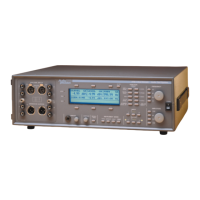In most cases, you will want to use HiZ terminations. The main
exception is when you are working with equipment that requires
600 Ω terminations. Check your device’s output specifications to see if
a termination of 600 Ω is required.
The analog generator’s output impedance and balanced/unbalanced
configuration is selected on the Generator Only Panel in Analog
Generator Control Mode. To get there, follow these steps:
The lower center soft key selects the generator output impedance and
configuration. The choices are ‘40 Ω UNBAL’, ‘40 Ω BAL’, ‘150 Ω
BAL’ and ‘600 Ω BAL’.
If your device under test has unbalanced inputs, you should select the
40 Ω unbalanced configuration.
If your device has balanced inputs, the 40 Ω balanced selection is
usually the desired choice. The 150 Ω and 600 Ω selections are
generally only used with devices that have an equivalent input
impedance. Check the input specifications for your device. For
devices with higher input impedances, choose 40 Ω.
Only one of the digital input connectors is used for input at a time.
The selection is automatic, depending on which input is active. If your
device has several different digital interfaces, and you want to test
them all, connect and test each one individually.
When the XLR connector is used for input, the BNC input connector
becomes a monitor output. It can be connected to an external
oscilloscope for monitoring of the XLR input signal.
The digital generator sends signals to all the digital output connectors
simultaneously. There is no way to disable one output while enabling
another.
The Digital I/O measurement function provides some important
information and control of the digital interfaces. Follow these steps to
get to the Main Panel in Digital I/O mode:
The upper center area of the screen shows which of the digital inputs is
currently selected for input, which is selected automatically.
3 Operation
Operational Overview External Connections
ATS-1 Dual Domain User's Manual 3-43

